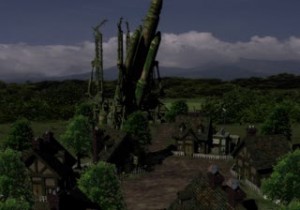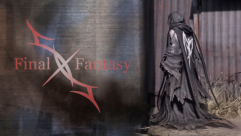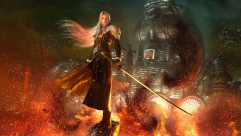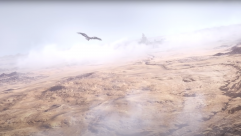News
Frequently Asked Questions Regarding FFVII – An Analysis by Squall_of_SeeD
by Makoeyes987
September 8, 2009

Excerpts from an FAQ article on FFVII written by Squall_of_SeeD, answering some of the frequently asked questions about plot points in FFVII and the Compilation thereof. The FAQ is hosted in its entirety on GameFAQs, where it includes this information and much more.
*Q: The box that held Jenova’s “head” in AC was a bit small for holding an
entire head. Was that what was actually in it?
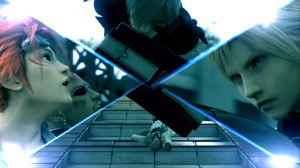
*A: According to Takeshi Nozue, co-director of the film, the contents of the box were referred to as the head, but what the box actually contains is just random remains of Jenova.
Of course, this might mean that some material from her head was within the box, but Nozue doesn’t indicate it to necessarily be the case. They simply refer to the box’s contents as “the head” for simplicity’s sake.
*Source: Advent Children Prologue book (pg. 62)
*Q: Why does Kadaj scream out in anguish when he looks into the box holding Jenova’s remains?
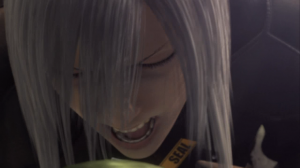
*A: According to the script of the film packaged with the Advent Pieces Limited edition in Japan, as well as the script included with the Limited Edition Collector’s Set release in North America, Cloud damaged the box further than Rufus’s earlier shot already had.
The contents of the box were damaged as a result of these attacks, and Kadaj probably assumed that what should have been a healthy looking part of Jenova had been mangled — and that she had, thus, been hurt. So he was grieving, basically.

*Q: What was that rain that Aerith brought which cleansed people of Jenova’s cells and disintegrated Kadaj, Yazoo and Loz?
*A: It was most likely a representation of Aerith’s Great Gospel Limit Break, which would completely heal party members in Final Fantasy VII and fell from the sky as rain.
As far as what it was in plainer terms, it looked like Lifestream mixed with water. When looking at the hole that Kadaj blasted into the floor of Aerith’s old church, one can clearly see the Lifestream mixing with water.
Once Sephiroth was out of the picture, Aerith unleashed the city-wide Great Gospel seen at the end of the film.
Q: What were those dark clouds Sephiroth called forth before his battle with Cloud began? Some of them took the form of tendrils like the Lifestream.

*A: It was a Lifestream composed of the spirit energy of those who had died of geostigma. Their spirit energy became contaminated by the influence of Jenova’s cells and was, thus, under Sephiroth’s control.
*Source:Staff commentary from Japanese Advent Pieces Limited edition of AC; FFVII 10th Anniversary Ultimania (pg. 32)
The silver-haired men — Kadaj, Yazoo and Loz — also had limited control over this “negative Lifestream,” as seen when they summoned the Shadow Creeper monsters who were composed of it.
*Q: What is the black substance that permeates the water at the City of the Ancients when Kadaj steps into it? Why do the silver-haired men have the children drink the water?

*A: It was Kadaj’s will. He had them drink the water to activate the Jenova cells within them — specifically, the instinct for Reunion.
*Source: Staff commentary from Japanese Advent Pieces Limited edition of AC
The idea was that the children would then be drawn to the location of
Jenova’s remains, allowing the silver-haired men to locate their
“mother.” They couldn’t track her themselves because they didn’t have any Jenova cells in their bodies.
*Q: Why didn’t Rufus die in Final Fantasy VII when Diamond Weapon blasted his office? He started to explain, but Cloud interrupted him.

*A: He got lucky, I guess. It wasn’t the first time a Final Fantasy
character survived a large explosion at close range. Final Fantasy IV has more than one case of it.
For a detailed account of Rufus’s ordeal, see the official FFVII novella Episode:Shin-Ra from FFVII scenario writer Kazushige Nojima’s On the Way to a Smile series.
*Q: Didn’t Tseng die in Final Fantasy VII? Elena said to Cloud “…you really got guts doin’ my boss in like that!”
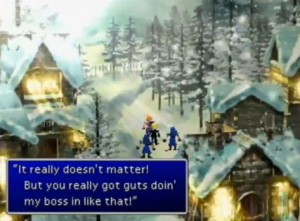
*A: If one speaks to the wounded Tseng in the Temple of the Ancients after he has given Cloud and company the Keystone, he will say “I’m… still alive… .” While Cloud and the others were inside the temple, Tseng was discovered and rescued by Cait Sith no. 2, operated via remote by Reeve, as recounted in Episode:Shin-Ra. The other Turks themselves believed Tseng to be dead until Diamond Weapon’s attack on Midgar.
Also of interest, while the PlayStation version of Final Fantasy VII released in North America made it seem that Tseng had died due to Elena’s statement, it was seemingly “corrected” with the PC release, in which she says “…you really got guts messin’ my boss up like
that!” despite her being unaware at the time that he is alive and it still being several more years before Tseng’s survival would be revealed to fans.
For those interested, by the way, Elena’s line in Japanese is よくも私のボスをやってくれたわね! (“How dare you do that to my boss!”).
Tseng’s absence throughout the rest of the original game certainly suggested to many, myself included, that he had died, even with Elena’s altered line in the PC version. That being said, the developers left themselves plausible room to bring him back.
*Q: What is written on the plaque on the monument in Edge?
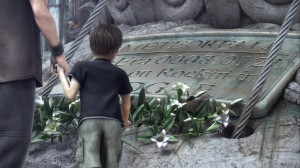
*A: In the original release of Advent Children, it read:
METEO IMPACT
ν-Era 0008 012[unknown final value]
Keep on Rockin’ in
MIDGAR
In Advent Children Complete, the plaque clearly reads:
METEORFALL
v-Era 0008 0121
Keep on Rockin’ in
MIDGAR
In the original release of the film, the second “1” in the date was obscured. In Advent Children Complete, the full date is visible, revealing that Meteorfall was on January 21st.
The “v,” by the way, is the lowercase form of Nu, the thirteenth letter of the Greek alphabet.
*Q: What was the name of the Bahamut that Kadaj summoned?
*A: Bahamut SIN (official romanization; technically “Shin” is also accurate), meaning “Bahamut Tremor.” In Japanese, its name is spelled “バハムート震.”
This name and those of the alternate forms of Bahamut seen in the original game came from old Japanese fighter planes. For instance, Bahamut ZERO is Bahamut Reishiki in Japanese (“Bahamut Zero Style” or “Bahamut Type-0”), and Neo Bahamut is Bahamut Kai (“Bahamut Remodeled”).
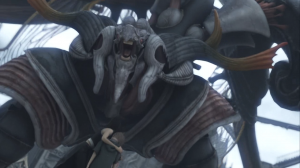
*Source:Staff commentary from Japanese Advent Pieces Limited edition of AC;
Advent Children Prologue book (pg. 45); AC Reunion Files book (pg. 76)
*Q: What does the wolf that appears at Zack’s place of death, Aerith’s church and the City of the Ancients symbolize?

*A: It’s a symbol of the guilt and regret Cloud experienced as a result of being unable to do anything to save Aerith and Zack, so it appears in locations related to them.
*Source: Staff commentary from Japanese Advent Pieces Limited edition of AC; AC Reunion
Files book (pg. 86)
The symbolism of the wolf also brings to mind the expression “lone wolf,” as Cloud has chosen to live away from others while he awaited death from geostigma. Continuing this line of symbolism, Cloud wears the design of a wolf’s head on his outfit, and his motorcycle is named Fenrir, the name bore by Loki’s wolf-child in Norse mythology.
*Q: What are the names of Cloud’s new swords?
*A: Takeyuki Takeya, the swords’ designer, has commented that he didn’t give them or their united form proper names. The developers just called them the Fusion Swords (Gattai Ken; 合体剣) during development.
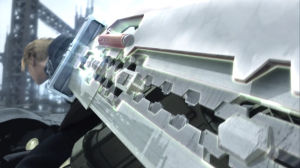
*Source: AC Reunion Files book (pp. 77-78)
While it doesn’t seem that any of the swords have been otherwise given official names, the base sword the others attach to has been called the First Sword (Saisho no Ken in Japanese) by Nomura.
*Source: Staff commentary from Japanese Advent Pieces Limited edition of AC
This FAQ originally gave the sword’s name as First Tsurugi, which has
apparently been a common misunderstanding since the kanji for “sword” (剣) can be read and pronounced both “ken” and “tsurugi.” The pronunciation Nomura actually used was “ken.”
*Q: What is the name of the Limit Break that Cloud defeats Sephiroth with in Advent Children?
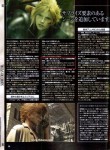
*A: The technique he uses in the original release of Advent Children was named “Omnislash Ver.5” — or “Omnislash Version 5.” According to Nomura, the rendition of the attack seen in the film was the fifth animation of it the development team designed.
In Advent Children Complete, Cloud uses a new attack to finish Sephiroth, Omnislash Ver.6.
*Sources: Staff commentary from Japanese Advent Pieces Limited edition of AC; April 2009 issue of Famitsu PSP+PS3 (issue #256; pg. 14)
*Q: What were the names of Kadaj, Yazoo and Loz’s weapons? What kind of weapons were they?
*A: -Kadaj’s weapon-
The Souba (a double-bladed katana)
-Yazoo’s weapon-
A Velvet Nightmare (a double-barreled gun that vaguely resembles a
sword)
-Loz’s weapons-
A Velvet Nightmare
The Dual Hound (a pile bunker designed to function as a stun gun)
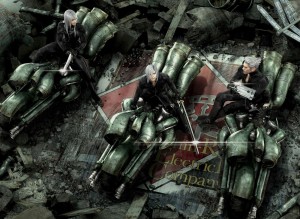
*Source: Official North American Advent Children website; Advent Children Prologue book (pg. 72); AC Reunion Files book (pg. 79)
*Q: Do the Velvet Nightmare weapons function as swords as well or only as guns?
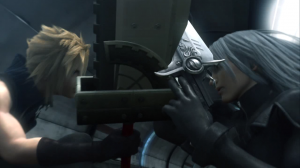
*A: They function only as guns. While Yazoo does use his Velvet Nightmare to block Cloud’s sword during a fight, the weapons lack an actual blade. Both the official North American and Japanese Advent Children websites state that the Velvet Nightmares lack any sword function:
(Yazoo’s profile on the official North American Advent Children website)
“A youth who is unbound by worldly matters and thus a bit of an enigma. Yazoo carries the ‘Velvet Nightmare,’ a firearm designed after two parallel swords, but with gun functionality only.”
*Q: Can Cloud fly?

*A: Not anytime he wants to like Vincent apparently can, but he does fly briefly when performing Omnislash Version 5/6 on Sephiroth at the end of the film.
Presumably, anyone could do it via a surge in their spirit energy — what we otherwise know as a Limit Break — and we do witness Aerith’s staff levitating during battles in the original game while she performed Limit Breaks or was casting spells.
*Q: Is Jenova male or female?
*A: While it typically appears as a female during the main events of the game, in light of its ability to change its shape and in light of it — or parts of it to be more specific — taking the form of Sephiroth during the course of the game, it cannot be reasonably classified as male or female with any strong measure of certainty. It may very well be without a biological sex.

In the years immediately following the release of the game, it was often believed that Jenova was considered a male by the Cetra based on a bad translation of lines from Ifalna in the original North American release of the game:
Gast
“Who is the person that appeared at the North Cave? I haven’t any idea.”
Ifalna
“That’s when the one who injured the Planet… or the ‘crisis from the sky’, as we call it, came.”
“He first approached as a friend, deceived them, and finally…… gave them the virus.”
“The Cetra were attacked by the virus and went mad… transforming into monsters.”
“Then, just as he had at the Knowlespole.”
“He approached other Cetra clans…… infecting them with… the virus…”
While this PlayStation version of the game’s script had Jenova referred to as a male at this point, in the later PC version — in which many errors were corrected — “it” was used in place of “he.”
*Q: Is Vincent immortal?
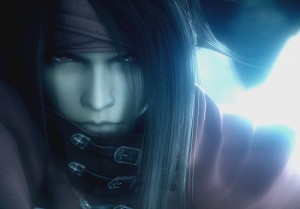
*A: Essentially. After being mortally wounded by Hojo approximately 23 years before the original game began and then being brought back to life through experimentation, Vincent has eternal youth. He’s now immortal, continuing to retain the youth he had at 27 years old decades later.
Whether this has remained the case post-Dirge of Cerberus, in which Vincent lost his possession by Chaos, is unclear.
*Source: FFVII Ultimania Omega guide (pg. 46); FFVII 10th Anniversary
Ultimania guide (pg. 68)
*Q: What is written on the plaque on the helmet Jenova wears in the Nibelheim flashback?
*A: It varies from one version of that scene to another. Thus far, there have been three different versions of the writing on the plaque. In the FMV from the original game, it read the following:
JENOVA
MADE IN HONG KONG
ALL RIGHTS RESERVED 1996
SQUER COMPANY LIMITED

In Advent Children, it read:
JENOVA
[μ]-Era 19591010 発見
[μ]-Era 19670702 封印
or
JENOVA
Discovery Mu-Era October 10, 1959
Sealing Mu-Era July 2, 1967

The alphabetical character between the two vertical bars is the lowercase form of Mu, the twelfth letter of the Greek alphabet. When I first wrote this FAQ, and even when I last left it, I had believed that this use of the letter was intended to identify the era in question as the “Middle-Era.”
I think I’d reached that conclusion because I’d read that this character was historically used to denote “middle” — as it is the twelfth of the twenty-four characters in the Greek alphabet — the same way alpha and omega were used to denote “beginning” and “end.”
Not really sure why I thought that made so much sense, though. The Greek letter on the monument in Edge is the lowercase form of the thirteenth letter in the alphabet, Nu (v), which — as far as I know — wasn’t used for any such purpose.
Finally, the appearance of the plaque in Last Order bears this inscription:
JENOVA
STRICT SECRECY
SCIENTIFIC INQUIRY SECTION
SHIN-RA COMPANY LIMITED

The roles of Jenova and Sephiroth: The Puppet Master Theorem

The longest and most intensely debated matter of Final Fantasy VII in the eight years following its release was this: Was Jenova or Sephiroth in control of the other during the events of Final Fantasy VII?
My initial belief was that Jenova was in complete control of a puppet-like Sephiroth, though I now think I took this position mainly in defiance of the hardcore Sephiroth fanbase. Later, my position would change in that I came to believe there was little distinction to be made between Jenova and Sephiroth by the time of FFVII.
My thoughts shifted to the idea that the two had essentially become one; that Sephiroth was Jenova in human flesh the same way Christianity sees Jesus Christ as God in human flesh. Given the game’s extensive use of Judaeo-Christian symbolism, that made the most sense to me at the time and continues to be my interpretation of things.
Square Enix’s officially stated position on the matter is somewhat ambiguous. In Sephiroth’s profile on pg. 53 of the FFVII Ultimania Omega, we find the following (click here for screenshot):
Sephiroth’s will and Jenova’s will
The Sephiroth copies who appear in various places all mumble Sephiroth’s name as they gather for the Reunion. Though it seems Jenova’s will consumed Sephiroth’s mind when he was a human, has his will actually taken control of Jenova …?
[Screenshot caption]
The voice of Sephiroth supercedes “Mother” Jenova and calls out to the cells in the copies.
セフィロスの意志とジェノバの意志
各地のセフィロス・コピーたちは、セフィロスの名を口々につぶやき、リユニオンのために集まっていく。ジェノバの意志が人間としてのセフィロスの心を食ったようでいて、じ つはセフィロスの意志がジェノバを支配したのか……。
[Screenshot caption]
セフィロスの声は”母”ジェノバを超え、コピーたちの細胞に呼びかける。
The passage stops short of outright declaring that Sephiroth’s will has rendered Jenova a mindless slave, though it does tell us that Jenova’s instincts influenced Sephiroth at least for a time in Nibelheim, which is a valuable matter to have confirmed. The full details of their symbiosis afterward are left unclear, though one may argue that the question posed by this passage is phrased in a leading manner.
Furthermore, while this passage has been translated differently by other fans in the past who took it more as a direct statement of Sephiroth controlling Jenova like a puppet, I contend that the above translation is more accurate and is reflected by comments in other official materials. Though Sephiroth’s personality was unquestionably the dominant one, I still believe that the virus-like behavior of Jenova is indicated by his ongoing desire to assimilate the entirety of the planet’s spirit energy and become one with the planet — much like a virus seeks to infect all that it can, as Jenova had attempted before being sealed by the Cetra.
Indeed, Sephiroth’s profile in the FFVII 10th Anniversary Ultimania says that he “inherited Jenova’s will to destroy the planet” (pg. 76; pg. 78 of the Revised Edition) and set out to achieve her “dreadful ambition” (pg. 78; pg. 80 of the Revised Edition).

Even in Advent Children, he speaks of assimilating the Lifestream, then traveling the cosmos like Jenova and finding a new world to assimilate. Whether he knew it or not, Sephiroth had the instincts of Jenova and the two were, in all relevant ways, the same being by the time FFVII took place.
Certainly the possibility was present for such a merge to occur given that Sephiroth fell into the Lifestream with Jenova’s head, only for his own body to be dissolved and then reconstructed, as according to the Advent Children Reunion Files (pg. 60) and FFVII Ultimania Omega (pg. 211). At any rate, even the official position, as stated in Final Fantasy VII’s Ultimania Omega, is that it was by virtue of having Jenova’s head with him in the Lifestream that Sephiroth was able to influence the location of the Reunion (pg. 212), if not altogether how he was able to take command of Jenova’s cells and power.
Most insightful of all, perhaps, are these comments from Cloud’s profile on pp. 38-39 of the FFVII 10th Anniversary Ultimania (pp. 40-41 of the Revised Edition):
“Cloud’s pupils narrow, just like those of the Remnants of Sephiroth. It’s almost as if he can never escape from Jenova’s command…”
“The only time he laughs in FFVII is during a conversation with Aerith at the start of the story, when Jenova is still in control of his consciousness.”
Seeing as it is Sephiroth’s command Cloud has actually been subject to, one wonders why the book chose to identify Jenova like this in the first quote — and the active voice assigned to her in the second seems to assign her more of a role than that of a vegetable. More than anything else, Sephiroth and Jenova’s names being used interchangeably like this points to the notion that the two had become the same being.
Along these same lines, the entries for Jenova and the Jenova Project in the FFVII 10th Anniversary Ultimania’s glossary of terms (pg. 31; pg. 33 of the Revised Edition) speak to Jenova being an active, involved participant in events:
“A life form from another planet, which arrived on the planet on a meteorite approx. 2000 years ago. While it is not yet completely clear what it truly is, it is extremely intelligent and has the ability to mimic any other living being. It has an instinctive drive to destroy planets, and is a highly dangerous entity, so — as the ‘Calamity from the Sky’ — it was sealed by the Ancients. It was excavated by the Shin-Ra Company and used as a valuable basis for human experiments, but — together with Sephiroth, who was created by those experiments — it once again came back into action to destroy the planet. Even though most of its physical body was lost during the Jenova War, its malevolent will remains, lurking in the Lifestream.”
“Jenova was a specimen that was mistaken for an Ancient. Based on these early mistaken perceptions, the Head of the Shin-Ra Science Department, Dr. Gast, began conducting experiments to resurrect an Ancient. The main goal of this experiment was to create an Ancient who could inherit the powers of the planet and lead them to riches, but the experiment ended up resulting in the revival of the great Calamity.”
Likewise for Jenova’s entry in the Crisis Core Complete Guide’s Keyword Collection:
“Its relation to Sephiroth is like that of a parent and child, and in FFVII it continued to work with Sephiroth to summon Meteor and destroy the planet. After the final battle, it was defeated by Cloud’s team and lost its physical body, but its mimetic legacy lived on within the Lifestream, and in AC it created Remnants such as Kadaj.”
Here, actions otherwise attributed directly to Sephiroth himself (e.g. the creation of Kadaj in On the Way to a Smile’s Lifestream Black entry) are attributed to Jenova. This once again demonstrates the interchangeable use of their names for the same entity.
The creature’s entry on the Dirge of Cerberus Official Complete Guide’s Term List (pg. 318) also point to Jenova being alive and conscious:
“A lifeform in suspended animation discovered in a 2000-year-old geological stratum. Initially identified as an Ancient, in reality, it is intelligent life from somewhere in space. It could read the memories and feelings of the people on the surface, and, so doing, approached the Ancients, using its “mimicry ability” to replicate appearances, voices and language. It exterminated most of the Ancients, but was also sealed by them. However, in the present 2000 years later, it would awaken after being discovered by Shin-Ra’s science division.”
Though none of these entries quite come out and say so directly, the message is clear that Sephiroth has become the great Calamity itself.
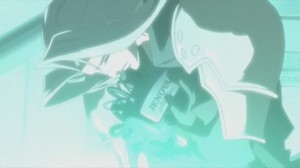
What are Bizarro Sephiroth and Safer Sephiroth?


Two frequently debated matters of Final Fantasy VII’s storyline in the past were also the nature of Bizarro Sephiroth and Safer Sephiroth. A matter difficult to pin down from the start due to neither form receiving any attention within the narrative was rendered all the more difficult due to the graphical limitations at the time of the game’s development.
However, from observing character designer Tetsuya Nomura’s designs of the two bosses, a guess at their nature can be determined.
Bizarro Sephiroth is actually a pupa-like entity in Sephiroth’s form (its bangs match Sephiroth’s hair — known among some in the fandom as “the Bangs of Doom”) from which Safer Sephiroth was emerging, thus the name of the background music for the Bizarro battle being “Birth of a God.”
This certainly fits due to the angelic and heavenly appearance of Safer Sephiroth. We can be certain that Safer Sephiroth was “hatching” from Bizarro Sephiroth due to the torso of Safer Sephiroth protruding from Bizarro Sephiroth’s head, as well as due to the wings of Safer Sephiroth extending from behind the smaller torso:

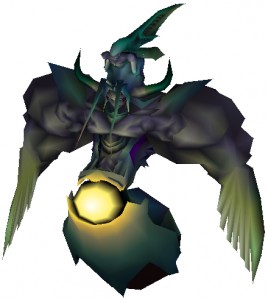
The biggest indication of this rebirth of Sephiroth is that the katakana in the name of Bizzaro Sephiroth (リバース・セフィロス) could be written out to mean “Rebirth Sephiroth” in addition to the “Reverse Sephiroth” understanding that apparently lent itself to becoming “Bizarro Sephiroth” in the official localization.
Was Cloud a failed Sephiroth copy?

Perhaps the most frequently misunderstood aspects of Final Fantasy VII’s story in the years immediately following its release were those related to the matter of Cloud being a Sephiroth copy. Aside from misinterpretations that this meant he was a genetic duplicate of Sephiroth, he was also usually believed to have been a failure in Hojo’s experiment involving the Sephiroth copies.
Where the confusion regarding this matter arises is from Cloud and Hojo’s conversation in the Northern Crater before Meteor is summoned:
Hojo
“Ha, ha, ha… this is perfect!!!”
“It means that my experiment was a complete success!”
Hojo
“What number were you? Huh? Where is your tattoo?”
Cloud
“Professor Hojo… I don’t have a number.”
“You didn’t give me one because I was a failed experiment.”
Hojo
“What the–? You mean only a failure made it here?”
Cloud
“Professor… please give me a number. Please, Professor…”
Hojo
“Shut up, miserable failure…”
What was often overlooked about this is that it was *Cloud* who told *Hojo* that Cloud was a failure, and — bearing his lack of a numbered tattoo as proof — Hojo believed him. For his part, Cloud believed that he was a failure based on his lack of a tattoo and what Sephiroth had told him moments earlier:
Sephiroth
“Ha, ha, ha……”
“I want to take you back to your real self.”
“The one who gave me the Black Materia that day…”
“Who would have ever thought a failed experiment would prove so
useful?”
“Hojo would die if he knew.”
Cloud
“Hojo!? What does he have to do with me!?”
Sephiroth
“Five years ago you were…”
…constructed by Hojo, piece by piece, right after Nibelheim was
burnt.”
“A puppet made up of vibrant Jenova cells, her knowledge, and the
power of Mako.”
“An incomplete Sephiroth-clone. Not even given a number. …That is
your reality.”
Deceived by this false information, Cloud believed that he not only wasn’t a normal human being, being instead constructed from Jenova cells infused with mako, but that he was also a failed component of Hojo’s experiment. This influenced what he told Hojo, and subsequently, Hojo’s feelings toward Cloud. What Cloud failed to recall at this time was that Zack broke himself and Cloud out of the Shinra Mansion before Cloud could be given a tattoo — for Cloud was not the failure at all. Zack was.

In defining who is and is not a failure in the experiment that Hojo was carrying out, one must recall what Hojo was attempting to test with the Sephiroth copies and how he was going about doing so. His Nibelheim experiment was conducted for the sake of testing his Jenova Reunion Theory.
In order to conduct this experiment, Hojo had the survivors of Sephiroth’s massacre in Nibelheim rounded up for experimentation. Once captured, they were infused with mako and injected with Jenova’s cells. A body and mind that displayed no response to the influence of Jenova’s cells would obviously be ill-suited for testing the validity of the Reunion Theory, as their own will may override Jenova’s attempt to call that individual.
With this in mind, only the weak-willed would be suitable for the
experiment, and, thus, successful. It was Cloud that had a reaction to Jenova’s cells, whereas Zack did not:
(from the Escapee Reports in the back of the Shinra Mansion’s library; note that Zack is Specimen A (the former member of SOLDIER), while Cloud is Specimen B (the regular))
Escapee Report No. 2
Description of the time of capture.
A – Former member of SOLDIER/Number ( )
No effect could be detected from either Mako Radiation Therapy or Jenova on him.
B – Regular/Number ( )
Reaction to Jenova detected.
Note also that in the parentheses where the two would have had numbers, there are blank spaces. They had not yet received numbers.
Further evidence for Cloud’s successful status comes from Hojo moments before his death. Hojo himself declares Cloud to be the only Sephiroth copy that was successful, as Cloud was the only one he saw at the Reunion:
Hojo
“Every time I see you, I…”
“It pains me that I had so little scientific sense…”
“I evaluated you as a failed project.”
“But, you are the only one that succeeded as a Sephiroth-clone.”
While Cloud was actually not the only successful copy — those in the
black cloaks were not seen by Hojo, as they had been killed moments before and their bodies cast down into the Northern Crater to be assimilated by Jenova — this still confirms his status as a success.
For those interested in an official source on this matter, see pg. 213 of Final Fantasy VII’s Ultimania Omega guide.
The answer to the once eternal question of Cloud’s failure or success as a Sephiroth copy is that he was a success.
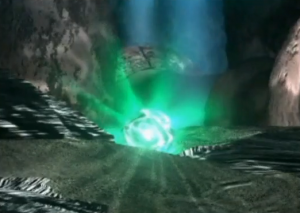
Was Aerith’s death necessary to summon Holy?
Another common misunderstanding from the old days of FFVII debate concerns Aerith’s death and Holy. Namely: Was it required that she die to cast the spell?
Aerith’s death actually wasn’t needed for it to work at all. The fact that Aerith didn’t intend to die nor know that she would be alone is enough to suggest it isn’t so, but we’ll examine the matter in more depth without focusing on that alone.
First, consider that the Black Materia — the key to activating Meteor, the Ultimate Destructive Magic — didn’t require a death in order to perform its casting. While true that the Cait Sith No. 1 construct remained in the Temple of the Ancients and was crushed while the temple transformed into the materia — as someone had to remain inside for the temple to shrink — this was to undo the Cetra’s security around the object and make the materia accessible, not to actually use the materia itself.
The White Materia — the key to activating Meteor’s opposite, Holy, the Ultimate White Magic — shouldn’t be any more likely to require death than the Black Materia, or any other for that matter. Despite the great destructive power of Meteor, it was never implied that it required such a sacrifice to function.
Also consider this: Sephiroth knew how the Black Materia worked from absorbing knowledge in the Lifestream. Knowing how the Black Materia worked, Sephiroth would logically also know how the White Materia worked. And quite obviously Sephiroth DID know about the White Materia, as he attempted to kill her before she could summon Holy, and was also holding Holy back for the second half of the game after Aerith summoned it.
If it were true that Aerith’ death was required for Holy to work, then it would have been counterproductive to Sephiroth’s plan to cause it. If Sephiroth’s intentions were to summon Meteor, initiating the key to activating Holy would be to undermine that entire plan.
Further consider that it is thoroughly explained in-game how activating Holy is done, and it isn’t mentioned then that a sacrifice is required:
—
Bugenhagen
“If a soul seeking Holy reaches the planet, it will appear.”
—
Many took this to mean that Aerith’s spirit had to rejoin the Lifestream in order to activate Holy. However, when put with the rest of what Bugenhagen says, this is shown to not be the case. “Reaching” the planet in this case merely meant “communicating with the planet” through the White Materia:
—
Cloud
“Search for Holy… How do we do it?”
Bugenhagen
“Speak to the planet.”
“Get the White Materia… This will bond the Planet to humans.”
Bugenhagen
“Then speak to the planet.”
“If our wish reaches the planet, the White Materia will begin to glow a pale green.”
—
The matter was as simple as that.
Anyone who had the White Materia could have prayed for Holy and “reached” the planet, as the White Materia opened a line of communication between its holder and the planet itself. The concept of establishing a link between oneself and the planet through the White Materia is no different than using any other materia, as each one contains the knowledge of those who have lived and died in the past, with these memories acting as a link between the wielder of the materia and the planet:
(Stated by Sephiroth in Nibelheim during the mission there five years before the main events of the game)
—
“…the knowledge and wisdom of the Ancients is held in the
materia.”
“Anyone with this knowledge can freely use the powers of the Land and the Planet. That knowledge interacts between ourselves and the planet calling up magic….. or so they say.”
—
Going beyond that which has been discussed to this point, if dying was the key to activating Holy, Aerith could have as easily thrown herself off a cliff or stood out in the open and called out to Sephiroth to come kill her rather than going about things as she did.
Even the FFVII Ultimania Omega guide makes no mention of death being required to summon Holy (pg. 215), saying merely that the mind of the White Materia’s wielder must be linked to the planet.
This is not to take anything away from Aerith, or to say that what she did wasn’t heroic. She was certainly brave, displaying heroism in traveling to the City of the Ancients on her own and in her willingness to endanger herself while trying to keep her friends out of the line of fire. This is merely to clarify the facts surrounding Aerith’s deeds.
With all that said, her death was still a stroke of luck on the planet’s part and would lead to its deliverance.
How can Cid be born in Rocket Town?
Official sources, such as Cid Highwind’s profile in the FFVII 10th Anniversary Ultimania, identify Cid’s birthplace as Rocket Town. But how can this be possible when it appears that the town was not there during the failed rocket launch, only four years before the original game takes place?
Seemingly, the easiest and most likely answer is that Cid could not have been born in Rocket Town and that the claim that it is his birthplace is an error.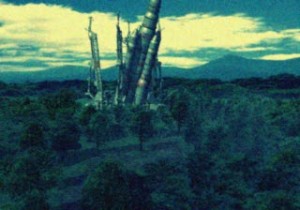 But can we find a way for this odd piece of canon to work? We might assume that the town was nearby before the development and launch of Shin-Ra’s many failed rockets, only not yet expanded to right next to the launch area. The town had gone by a different name up to this point, but after expansion was then bestowed a new one, “Rocket Town,” coined after the failed Shin-Ra No. 26 rocket.
But can we find a way for this odd piece of canon to work? We might assume that the town was nearby before the development and launch of Shin-Ra’s many failed rockets, only not yet expanded to right next to the launch area. The town had gone by a different name up to this point, but after expansion was then bestowed a new one, “Rocket Town,” coined after the failed Shin-Ra No. 26 rocket.
In this scenario, Cid would have been born in the prior, differently-named incarnation of Rocket Town, but — for simplicity’s sake — official materials would still identify his birthplace with the current name the same way a person born in one of the eight towns that became Midgar might be said to have been born in Midgar.
This is all speculation, though. Until the canon tries to explain itself, the most simple conclusion is that Cid was not born in Rocket Town and that no town existed there prior to the failed launch of Shin-Ra No. 26.
